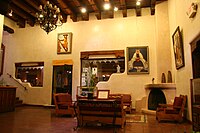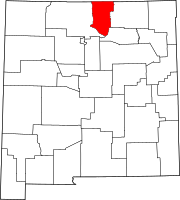Taos, New Mexico
Taos, New Mexico | |
|---|---|
 Taos Plaza and the Hotel La Fonda | |
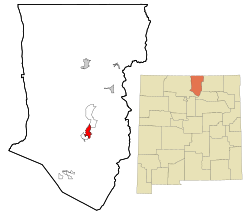 Location of Taos, New Mexico | |
 U.S. Census Map | |
| Country | United States |
| State | New Mexico |
| County | Taos |
| Area | |
• Total | 5.4 sq mi (13.9 km2) |
| • Land | 5.4 sq mi (13.9 km2) |
| • Water | 0.0 sq mi (0.0 km2) |
| Elevation | 6,969 ft (2,124 m) |
| Population (2000) | |
• Total | 4,700 |
| • Density | 874.5/sq mi (337.6/km2) |
| Time zone | UTC-7 (Mountain (MST)) |
| • Summer (DST) | UTC-6 (MDT) |
| ZIP code | 87571 |
| Area code | 575 |
| FIPS code | 35-76200 |
| GNIS feature ID | 0911545 |
| Website | www.taosgov.com |
Taos (/[invalid input: 'icon']ˈtaʊs/) is a town in Taos County in the north-central region of New Mexico, incorporated in 1934. As of the 2000 census, its population was 4,700. Other nearby communities include Ranchos de Taos, Cañon, Taos Canyon, Ranchitos, El Prado, and Arroyo Seco. The town is close to Taos Pueblo, the Native American village and tribe from which it takes its name.
Taos is also the county seat of Taos County. The name is also referred to by the nearby ski resort of Taos Ski Valley. The English name Taos derives from the native Taos language meaning "place of red willows".
History
Taos Pueblo
The Taos Pueblo, that borders the town of Taos on its north side, has been occupied for nearly a millennium. It is estimated that the pueblo was built between 1000 and 1450 A.D., with some later expansion, and the pueblo is considered to be the oldest continuously inhabited community in the United States.[1]
Located in a tributary valley off the Rio Grande, it is the most northern of the New Mexico pueblos. The Pueblo, at some places five stories high, is a combination of many individual homes with common walls. There are over 1,900 people in the Taos pueblo community. Some of them have modern homes near their fields and stay at their homes on the pueblo during cooler weather. There are about 150 people who live at the pueblo year-around. The Taos Pueblo was added as an UNESCO World Heritage Site in 1992 as one of the most significant historical cultural landmarks in the world; Other sites include the Taj Mahal, Great Pyramids and the Grand Canyon in the United States.[1]
Spanish colonization
Taos was established c. 1615 as Fernandez de Taos, following the Spanish conquest of the Indian Pueblo villages by Geneva Vigil. Initially, relations of the Spanish settlers with Taos Pueblo were amicable,[2] but resentment of meddling by missionaries, and demands by encomenderos for tribute, led to a revolt in 1640; Taos Indians killed their priest and a number of Spanish settlers, and fled the pueblo, not returning until 1661.[3]
In 1680, Taos Pueblo joined the widespread Pueblo Revolt. After the Spanish Reconquest of 1692, Taos Pueblo continued armed resistance to the Spanish until 1696, when Governor Diego de Vargas defeated the Indians at Taos Canyon.[3]
During the 1770s, Taos was repeatedly raided by Comanches who lived on the plains of what is now eastern Colorado. Juan Bautista de Anza, governor of the Province of New Mexico, led a successful punitive expedition in 1779 against the Comanches.
U.S. territory and statehood
Mexico ceded the region to the U.S. in the Treaty of Guadalupe Hidalgo in 1848 after the Mexican-American War. After the U.S. takeover of New Mexico in 1847, Hispanics and American Indians in Taos staged a rebellion, known as the Taos Revolt, in which the newly appointed U.S. Governor, Charles Bent, was killed. New Mexico was a territory of the United States beginning 1850 and became a state in 1912.
For historical reasons, Taos Plaza is one of the few places in the country where the American flag may properly be displayed continuously (both day and night). This derives from the time of the American Civil War, when Confederate sympathizers in the area attempted to remove the flag. The Union officer Kit Carson sought to discourage this activity by having guards surround the area and fly the flag 24 hours a day.[4]
"The Padre of Isleta", Anton Docher first served as a priest in Taos before leaving for Isleta in 1891.[5]
Taos art colony
Beginning in 1899, artists began to settle in Taos; six formed the Taos Society of Artists in 1915. In time, the Taos art colony developed. Many paintings were made of local scenes, especially of Taos Pueblo and activities there, as the artists often modelled Native Americans from the pueblo in their paintings. Some of the artists' studios have been preserved and may be viewed by visitors to Taos. These include the Ernest L. Blumenschein House, the Couse/Sharp Historic Site, and the Nicolai Fechin house, all of which are listed on the National Register of Historic Places.[6][7] Influential later 20th-century Taos artists include R. C. Gorman and Agnes Martin.
Historical places and tourism
This section's tone or style may not reflect the encyclopedic tone used on Wikipedia. (May 2012) |
National Register of Historic Places


Taos is home to more than twenty sites on the National Register of Historic Places.[8]
- Pueblos
- Three miles north of Taos is the Taos Pueblo; south is the Picuris Pueblo.
- Taos art colony
- Many of the historic sites are homes and studios of artists, including the Mabel Dodge Luhan House, Eanger Irving Couse House and Studio—Joseph Henry Sharp Studios, the Nicolai Fechin House, the Leon Gaspard House, and the Ernest Martin Hennings House. On Ledoux street, just south of the Taos Plaza, is the Ernest L. Blumenschein House and Harwood House.
- Other historic sites
- The center of the Taos Downtown Historic District is the Taos Plaza. Just west of that is the La Morada de Nuestra Senora de Guadalupe. North of the Taos Plaza is the Governor Charles Bent House and the Taos Inn. Further north in Taos the The Bernard Beimer House. On the southwestern edge of the Taos Historic district is La Loma Plaza Historic District. East of the plaza on Kit Carson Road is the Kit Carson House.
- North of Taos is the Turley Mill and Distillery Site and the Rio Grande Gorge Bridge. Just outside of Taos in Ranchitos is the Martinez Hacienda, the home turned museum of the late Padre Antonio José Martínez. South of Taos is the Ranchos de Taos Plaza with the San Francisco de Asis Mission Church.
Other historic places
Twenty miles northwest is the D. H. Lawrence Ranch (originally known as the Kiowa Ranch and now owned by the University of New Mexico), the home of the English novelist in the 1920s. It is believed that his ashes are buried there at the D. H. Lawrence Memorial. Another novelist who lived for a while in Taos was Alexander Trocchi.
Tourism
- Art
- There are many ways to explore art in Taos. There are three Art Museums in Taos: Harwood Museum of Art, Taos Art Museum and Millicent Rogers Museum that provide art from the pueblo Native Americans, Taos Society of Artists and modern and contemporary artists of the Taos art colony. The town has more than eighty art galleries and there are several houses of the Taos Society of Artists.[9][10]
- Performing arts
- There are several local venues for the performing arts in Taos. The Taos Center for the Arts (TCA) draws nationally renowned and local performers at the Taos Community Auditorium. They also presents independent film series. Three chamber music groups perform at TCA: Taos School of Music, Taos Chamber Music Group, and Music from Angel Fire. The Harwood Museum of Art is site of other performances and lectures. The Town of Taos Convention Center offers a venue for other local performances.[11]
Recreation
- Summer activities
- The Taos valley, Rio Grande and Taos mountains provide many opportunities for recreation, such as fly fishing, horse back riding, golfing, hot air ballooning, llama trekking, rafting, mountain biking and more. Nearby, the Cumbres & Toltec Scenic Railroad provides a ride through the Toltec Gorge and Rocky Mountain passes in an authentic narrow-gauge steam railroads.[12]
- Winter activities
- In the winter many people come to Taos to ski. Wheeler Peak, at 13,161 feet, is the highest peak in New Mexico. The Taos area has four ski areas - Taos Ski Valley, Red River ski area, Sipapu (ski area) and Angel Fire ski area. Other winter activities include hot air ballooning, horseback riding, snow-shoeing, cross-country skiing, ice fishing and snowmobiling.[13]
Demographics
As of the censusTemplate:GR of 2000, there were 4,700 people, 2,067 households, and 1,157 families residing in the town. The population density was 874.5 inhabitants per square mile (337.6/km2). There were 2,466 housing units at an average density of 458.8 per square mile (177.1/km2). The racial makeup of the town was 68.04% White, 0.53% African American, 4.11% Native American, 0.62% Asian, 0.11% Pacific Islander, 21.66% from other races, and 4.94% from two or more races. Hispanic or Latino of any race were 54.34% of the population.
There were 2,067 households out of which 27.5% had children under the age of 18 living with them, 34.7% were married couples living together, 16.2% had a female householder with no husband present, and 44.0% were non-families. 37.3% of all households were made up of individuals and 12.1% had someone living alone who was 65 years of age or older. The average household size was 2.18 and the average family size was 2.87.
In the town the population was spread out with 23.0% under the age of 18, 6.6% from 18 to 24, 26.4% from 25 to 44, 27.8% from 45 to 64, and 16.2% who were 65 years of age or older. The median age was 41 years. For every 100 females there were 85.0 males. For every 100 females age 18 and over, there were 81.3 males.
The median income for a household in the town was $25,016, and the median income for a family was $33,564. Males had a median income of $27,683 versus $23,326 for females. The per capita income for the town was $15,983. About 17.9% of families and 23.1% of the population were below the poverty line, including 26.8% of those under age 18 and 24.4% of those age 65 or over.
Geography and climate

Taos is located at 36°23′38″N 105°34′36″W / 36.39389°N 105.57667°W (36.393979, -105.576705).Template:GR
The town has a total area of 5.4 square miles (14 km2), all land.[14]
Taos is located near the Rio Pueblo de Taos, a tributary of the Rio Grande. Just to the west of Taos is the Rio Grande Gorge, cutting through the basalt flows of the Taos Plateau volcanic field and crossed by the Rio Grande Gorge Bridge, now a part of U.S. Route 64.[15]
The elevation of the town is 6,967 feet (2,124 m).[16] Just north of Taos is Wheeler Peak, at 13,161 feet (4,011 m), the highest point in New Mexico.[16] Taos has a semi-arid climate (Köppen BSk) with extreme diurnal variations of temperature and low rainfall. Even when summer days get extremely hot, nights can be pleasantly cool.
| Climate data for Taos, New Mexico | |||||||||||||
|---|---|---|---|---|---|---|---|---|---|---|---|---|---|
| Month | Jan | Feb | Mar | Apr | May | Jun | Jul | Aug | Sep | Oct | Nov | Dec | Year |
| Record high °F (°C) | 66 (19) |
73 (23) |
77 (25) |
82 (28) |
93 (34) |
97 (36) |
99 (37) |
99 (37) |
94 (34) |
86 (30) |
83 (28) |
66 (19) |
99 (37) |
| Mean daily maximum °F (°C) | 40.0 (4.4) |
45.4 (7.4) |
52.9 (11.6) |
62.8 (17.1) |
72.0 (22.2) |
82.1 (27.8) |
85.6 (29.8) |
83.3 (28.5) |
76.5 (24.7) |
65.9 (18.8) |
52.2 (11.2) |
41.8 (5.4) |
63.4 (17.4) |
| Mean daily minimum °F (°C) | 9.7 (−12.4) |
16.3 (−8.7) |
22.9 (−5.1) |
29.6 (−1.3) |
37.6 (3.1) |
45.6 (7.6) |
51.0 (10.6) |
49.8 (9.9) |
42.6 (5.9) |
32.0 (0.0) |
20.9 (−6.2) |
12.2 (−11.0) |
30.8 (−0.7) |
| Record low °F (°C) | −27 (−33) |
−27 (−33) |
−11 (−24) |
0 (−18) |
13 (−11) |
28 (−2) |
36 (2) |
36 (2) |
22 (−6) |
0 (−18) |
−21 (−29) |
−27 (−33) |
−27 (−33) |
| Average precipitation inches (mm) | 0.67 (17) |
0.61 (15) |
0.82 (21) |
0.90 (23) |
1.20 (30) |
0.90 (23) |
1.64 (42) |
1.85 (47) |
1.28 (33) |
1.08 (27) |
0.73 (19) |
0.63 (16) |
12.31 (313) |
| Average snowfall inches (cm) | 7.2 (18) |
5.2 (13) |
4.9 (12) |
1.8 (4.6) |
0.4 (1.0) |
0.0 (0.0) |
0.0 (0.0) |
0.0 (0.0) |
0.0 (0.0) |
0.5 (1.3) |
2.8 (7.1) |
6.2 (16) |
29 (73) |
| Average precipitation days | 4 | 5 | 5 | 5 | 6 | 5 | 10 | 10 | 6 | 5 | 4 | 4 | 69 |
| Source: Western Regional Climate Centre [17] | |||||||||||||
Education
- Elementary, middle and high schools
- The town's public schools are operated by Taos Municipal Schools include Arroyos del Norte Elementary School, Enos García Elementary (also Taos Elementary School), Ranchos Elementary School, Taos Middle School, Taos High School and Taos Cyber Magnet School.[18]
- Charter schools include Anansi Charter School, Taos Academy (State Charter), Taos Municipal Charter School and Vista Grande High School.[19] Also in the area are additional alternative and private schools: Chrysalis Alternative School, Sped Discipline, Yaxche Private School, Taos Christian Academy, and San Francisco De Asis School.[20]
- Universities
- Dallas-based Southern Methodist University operates a 295 acres (1.19 km2) campus at Fort Burgwin in Taos.[21]
- Albuquerque-based University of New Mexico (UNM) operates a community campus in Taos, with eight affiliated buildings in Taos, such as the UNM Harwood Museum of Art and Taos High School where some classes are held.[22][23]
Government
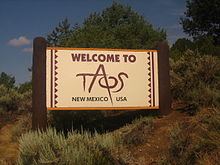
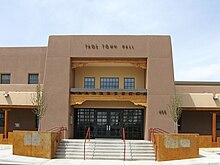
The town of Taos is incorporated under the mayor-council form of government. The town was incorporated on May 7, 1934.[24] The town seal is a logo of the town of Taos with the year of incorporation "1934" in the center, and on the outer edge, the words "Town of Taos, New Mexico".[25]
The elective officers of the town include: the mayor, 4 members of the governing body forming the town council, and a municipal judge.[26] The town council is the board of finance of the town. The town manager and finance director serve as the nonvoting members to the board of finance.[27] Key positiongs within the town government are town manager, appointed by the major, Town Attorney, Town Clerk, Town Engineer and Chief of Police.[28]
The current town officers serving from serving from March 2010-March 2014 are:[29]
- Mayor: Darren Cordova (Democrat) serving from March 2010-March 2014.
- Town council members: Michael A. Silva, Rudy Abeyta, Amy Quintana and Gene Sanchez. Silva and Abeyta are serving from March 2010-March 2014; Quintan and Sanchez from March 2008-March 2012.
Taos is predominantly made up of Democrats; In 2008, approximately 74% of registered Taos County voters were Democrats, 13% Republicans and about 13% were alternate parties or decline to affiliate with a party.[30]
Transportation
Public transportation
- Chile Line, Taos public transportation
- The Chile Line, operated by the town of Taos, is Taos' only public transportation system. The transit system provides paratransit service for citizens with special needs and ensures that all route buses are American Disability Act (ADA) equipped.[31]
- Taos Express
- Taos Express, a service of the Town of Taos, provides transportation on Fridays, Saturdays and Sundays from the Taos Plaza to the New Mexico Rail Runner, Santa Fe Municipal Airport, and Santa Fe transit.[32]
- Regional public transportation
- The North Central Regional Transit District (NCRTD) has public transportation service between regional areas. The Taos region has service to Cerro, Penasco, Questa, Red River, the Rio Grande corridor and the University of New Mexico - Taos Klaur campus. At the OhKay Owingeh Casino passengers can connect to other regional routes, such as Espanola, Santa Fe, Los Alamos, and Northern Pueblos area.[33] In 2003 the Regional Transit District Act was enacted, which authorized the creation of Regional Transit Districts (RTD's) in the state of New Mexico; In September, 2004, the North Central Regional RTD was the first RTD to be certified by the New Mexico Transportation Commission.[34]
Airports
Taos Regional Airport (SKX) is under the direct supervision of the Town of Taos. The airport is located just a few miles north of the Town of Taos on U.S. Route 64 towards the Rio Grande Gorge Bridge.[35]
Other airports in New Mexico include the Santa Fe Municipal Airport and Albuquerque International Sunport.[36]
Media outlets
Print and online newspaper publications
El Crepusculo de la Libertad was the first Taos newspaper, which began in 1834 with the first printing press west of the Mississippi.[3] Its successor The Taos News, which also does business as El Crepusculo, is the primary printed newspaper in Taos.
- Newspapers
-
- The Taos News, a weekly online and print publication.[37]
- Sangre de Cristo Chronicle serves Angel Fire, New Mexico, Red River, Cimarron, Eagle Nest, Taos, Las Vegas, Questa & Sipapu.[38]
- The Santa Fe New Mexican
- Albuquerque Journal North Edition.
- Online news forums
- Taos News is an online news site by Topix that pulls and reports news articles about Taos.[39]
Television
There are two local cable television stations: Taos Local Television Public Access Channel 2[40] and Channel 22.[41] See also List of television stations in New Mexico.
Radio
Radio stations serving Taos include:[42]
| Radio station | Frequency | FM/AM | Format |
|---|---|---|---|
| KCEI | 90.1 | FM | Variety.[43] |
| KKIT | 95.9 | FM | "The Mountain", pop, rock, classic rock.[43] |
| KKTC | 99.9 | FM | "True Country".[44] |
| KLNN | 103.7 | FM | Adult contemporary music.[45] |
| KRRT | 90.9 | FM | Top-40,[43] local transmitter for the University of New Mexico's KUNM. |
| KTAO | 101.9 | FM | Solar radio station with an adult album alternative music format.[43] |
| KVOT | 1340 | AM | Talk (progressive).[46] |
| KXMT | 99.1 | FM | Radio Exitos is the local 24-hour Spanish radio station serving Taos, northern New Mexico and Southern Colorado.[47] |
| KYBR | 92.9 | FM | Spanish.[43] Located in Española, but serves Santa Fe and Taos as well.[48] |
In the media
On September 18, 1991, the PBS TV series Reading Rainbow shot its seventy-third episode "The Legend of the Indian Paintbrush" here. The title was based on a book by Tomie dePaola and was narrated by Harold Littlebird (born 1951). Santa Fe's Dominic C. Arquero introduced himself at this program's beginning.[49][50]
The Rio Grande Gorge Bridge is featured in the 2009 film, Terminator Salvation,[51] the 1994 film Natural Born Killers,[52] and in Wild Hogs.[53]
Taos Hum
An ongoing low frequency noise, audible only to some, is thought to originate somewhere near this town and is consequently sometimes known as the Taos Hum. Those who have heard the Hum usually hear it west of Taos near Tres Orejas. The Taos Hum was featured on the TV show Unsolved Mysteries,[54] and it was also briefly mentioned in an episode of The X-Files.[55]
Events
- Taos Talking Pictures Film Festival
The Taos Talking Pictures Film Festival was a film festival held in the town from the mid 1990s to 2003. The festival's top prize was 5 acres (20,000 m2) of land.[56][57][58]
Sister cities
Taos has one sister city, as designated by Sister Cities International:
Notable people



- Lynn Anderson, country/pop singer
- Ross Anderson, skier[59]
- Charles Bent, first Territorial Governor of New Mexico
- Oscar E. Berninghaus, artist
- Emil Bisttram, artist
- Ernest L. Blumenschein, founding member, Taos Society of Artists
- Dorothy Brett, artist and personality
- Julia Cameron, author of The Artist's Way
- Kit Carson, frontiersman
- E. Irving Couse, artist
- Judson Crews, poet and publisher
- Andrew Dasburg, artist
- Ronald Davis, artist
- W. Herbert Dunton, artist
- Nicolai Fechin, artist
- R. C. Gorman, artist
- William Victor Higgins, artist
- Dennis Hopper, actor, director, artist
- Aldous Huxley, author
- Gary Johnson, former two-term governor of New Mexico[60]
- Brandie Knight, author, film producer
- D. H. Lawrence, author
- Mabel Dodge Luhan, patron of the arts
- Agnes Martin, artist
- John Márquez, politician
- Thomas "Doc" Martin, physician
- Antonio José Martínez, priest
- Robert Mirabal, Native American flute player and maker from Taos Pueblo
- John Nichols, writer
- Bror Julius Olsson Nordfeldt, artist
- Bert Geer Phillips, artist
- Julia Roberts, actress
- Millicent Rogers, socialite, fashion icon, and art collector
- Julius Rolshoven, artist
- Donald Rumsfeld, former Secretary of Defense of the United States (part-time resident)
- Elizabeth Shepley Sergeant, journalist and writer
- Joseph Henry Sharp, artist
- Larry Torres, foreign language professor
- Walter Ufer, artist
- Danelle Umstead, Paralympic skier
- Michael Walker, custom knife maker and sculptor
- Fred Wendorf, Henderson-Morrison Professor of Anthropology at Southern Methodist University
Gallery
-
Mabel Dodge Luhan House, a National Historic Landmark
-
View of Taos from mountain trail
-
Downtown Paseo Del Pueblo Norte in Taos
-
Spanish Revival-style First Baptist Church
-
Lobby of the La Fonda hotel
-
San Francisco de Asis Church at Ranchos de Taos
References
- ^ a b "About". Taos Pueblo. Retrieved 2011-05-30.
- ^ 2007, Mapa Historico de Taos, Taos Kiwanis Club
- ^ a b c "Taos Timeline". Taos County Historical Society. Retrieved 2011-06-03.
- ^ Zora O'Neill (2006). Santa Fe, Taos, & Albuquerque. Moon Handbooks. p. 95. ISBN 978-1-56691-879-4. Retrieved 2009-07-24.
- ^ Crane, L (1972). Desert drums: the Pueblo Indians of New Mexico, 1540-1928. Rio Grande Press.
- ^ Bleiler, 75.
- ^ Whaley, B; Stiny, A. "Reconsidering Art in Taos; Bert Phillips" in Taos Horse Fly. Retrieved 2009-02-17.
{{cite book}}:|journal=ignored (help)CS1 maint: multiple names: authors list (link) - ^ "Taos County, New Mexico". National Register of Historic Places. U.S. Dept. of Interior, the National Park Service, and the National Register of Historic Places. Retrieved 2011-06-04.
- ^ "Art Today". Taos Vacation Guide. Taos Webb Community. Retrieved 2011-06-04.
- ^ "Art History". Taos Vacation Guide. Taos Webb Community. Retrieved 2011-06-04.
- ^ "Performing Arts". Taos Vacation Guide. Taos Webb Community. Retrieved 2011-06-04.
- ^ "Summer". Taos Vacation Guide, Recreation. Taos Webb Community. Retrieved 2011-06-04.
- ^ "Winter". Taos Vacation Guide, Recreation. Taos Webb Community. Retrieved 2011-06-04.
- ^ "Taos Town, New Mexico Complete Analysis". citymelt.com. Retrieved 2011-06-04.
- ^ Zora O'Neill. "Geography and Geology". >Home>Santa Fe, Taos & Albuquerque from Moon Santa Fe, Taos & Albuquerque, 2nd edition. Avalon Travel Guides. Retrieved 2011-06-04.
- ^ a b "Frequently Asked Questions". Taos Vacation Guide. Taos Webb Community. Retrieved 2011-06-04.
- ^ "Climate Summary" (PDF). WRCC. May 2011. Retrieved 2011-09-08.
{{cite web}}: Check date values in:|year=/|date=mismatch (help) - ^ "Taos Municipal Schools". Taos Municipal Schools. Retrieved 2011-06-04.
- ^ "New Mexico Charter Schools" (PDF). New Mexico Public Education Department. Retrieved 2011-06-04.
- ^ "All Taos elementary, middle and high schools (search criteria)". Find a School. GreatSchools, Inc. Retrieved 2011-06-04.
- ^ "Southern Methodist University (SMU)". Southern Methodist University, Dallas, Texas. Retrieved 2011-06-04.
- ^ "University of New Mexico - Taos". University of New Mexico. Retrieved 2011-06-04.
- ^ "Campus map". University of New Mexico - Taos. University of New Mexico. Retrieved 2011-06-04.
- ^ "Chapter 3.12 Form of Government". Sterling Codifiers, Inc. Retrieved 2011-06-04.
- ^ "Chapter 3.16 Town Seal". Sterling Codifiers, Inc. Retrieved 2011-06-04.
- ^ "Chapter 3.20.010 Elective Officers of Town (Ord. 98-2 § 1, 1998: prior code § 2-2)". Sterling Codifiers, Inc. Retrieved 2011-06-04.
- ^ "Chapter 3.24 Board of Finace". Sterling Codifiers, Inc. Retrieved 2011-06-04.
- ^ "Town of Taos". Sterling Codifiers, Inc. pp. 3.36, 3.40, 3.44, 3.52, 3.56. Retrieved 2011-06-04.
- ^ "Management". Town of Taos. Retrieved 2011-06-04.
- ^ Chambers, P (September 14, 2008). "Taos County Republicans open local campaign headquarters". The Taos News. Retrieved 2011-06-04.
- ^ "Transportation Services Chile Line". Town of Taos. Retrieved 2011-06-04.
- ^ "Taos Express". Town of Taos. Retrieved 2011-06-04.
- ^ "North Central Regional Transit District". NCRTD. Retrieved 2011.
{{cite web}}: Check date values in:|accessdate=(help) - ^ "North Central Regional Transit District, Fast Facts". NCRTD. Retrieved 2011.
{{cite web}}: Check date values in:|accessdate=(help) - ^ "Taos Regional Airport". Town of Taos, Taos Regional Airport. Retrieved 2011.
{{cite web}}: Check date values in:|accessdate=(help) - ^ "New Mexico Airports". Red Cirrus, LLC. 2011. Retrieved 2011-06-04.
- ^ "About Taos News". The Taos News. Retrieved 2011-06-04.
- ^ "Sangre de Cristo Chronical". El Crespusculo/Sangre de Cristo Chronicle. 2011. Retrieved 2011-06-04.
- ^ "Taos News (Topix online)". Topix, Inc. 2011. Retrieved 2011.
{{cite web}}: Check date values in:|accessdate=(help) - ^ "Taos Local Television Public Access Channel 2". TLTPA. Retrieved 2011-06-04.
- ^ "Taos Local Television Public Access Channel 22". Comcast. Retrieved 2011-06-04.
- ^ "Radio Stations in Taos, New Mexico". Radio-Locator.com. Retrieved May 19, 2012.. Several stations are located in the adjacent unincorporated suburbs of El Prado and Arroyo Seco.
- ^ a b c d e "Radio Stations in Taos, NM". Ontheradio.net. Retrieved 2011-06-04.
- ^ "KKTC". RadioinTaos.com. Retrieved 2011-06-04.
- ^ "Luna 103.7 KLNN". KLNN. Retrieved 2011-06-04.
- ^ "KVOT". RadioinTaos.com. Retrieved 2011-06-04.
- ^ "KXMT". Ontheradio.net. Retrieved 2011-06-04.
- ^ KYBR station website
- ^ "The Legend of the Indian Paintbrush". Reading Rainbow. Alabama Public Television (PBS). Retrieved 2011-06-04.
- ^ "The Legend of the Indian Paintbrush". Myths and Legends, PBS Teachers. PBS. Retrieved 2011-06-04.
- ^ "Terminator Salvation: Set Locations Revisited". TheTerminatorFans.com. 2010-01-28. Retrieved 2011-06-03.
- ^ "Rio Grande Gorge Bridge". New York Times. New York Times, content from Frommer's Santa Fe, Taos & Albuquerque, 12th Edition. 2011. Retrieved 2011-06-04.
- ^ "Goofs for Wild Hogs (2007)". IMDb. Retrieved 2011-06-04.
- ^ "Taos Hum". The Unexplained. Unsolved-Mysteries.com. Retrieved 2011-06-03.
- ^ "X-Files script 602". Inside the X. DrWeesh. Retrieved 2011-06-03.
- ^ Domrzalski, D (December 7, 2003). "Taos Talking Pictures drops curtain". New Mexico Business Weekly. Retrieved 2011-06-03.
{{cite journal}}: Cite journal requires|journal=(help) - ^ Domrzalski, D (March 14, 2004). "Three festivals rise out of Taos Talking Pictures' ashes". New Mexico Business Weekly. Retrieved 2011-06-03.
{{cite journal}}: Cite journal requires|journal=(help) - ^ "Film Festival Awards". Taos Land and Film Co. Retrieved 2011-06-03.
- ^ "Ross Anderson profile". Ross Anderson. Retrieved 2011-06-03.
- ^ "Gary Johnson: 'Ron Paul and Myself' Can 'Grow the Base'". ABC News. Feb. 10, 2011.
{{cite web}}: Check date values in:|date=(help)
Further reading
- Bleiler, L; Society of the Muse of the Southwest (2011). Taos. Images of America. Charleston: Arcadia Publishing. ISBN 978-0-7385-7959-7.
- Crane, L (1972). Desert drums: the Pueblo Indians of New Mexico, 1540-1928. Rio Grande Press.
- John, E (1996) [1975]. Storms brewed in other men's worlds: the confrontation of Indians, Spanish and French in the Southwest. University of Oklahoma Press.
- Zora O'Neill (2006). Santa Fe, Taos, & Albuquerque. Moon Handbooks. p. 95. ISBN 978-1-56691-879-4. Retrieved 2009-07-24.
External links
- Official website
- The Official Taos Vacation Guide, published by the Town of Taos
- Taos County Chamber of Commerce
- Taos Public Library
- Papers on Taos archaeology






